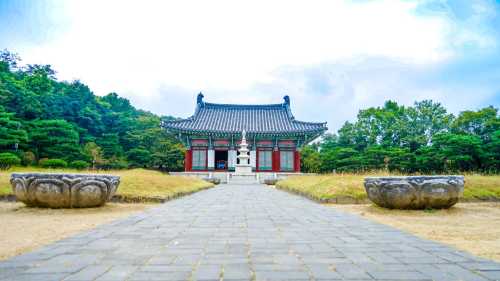Popular Trip Moments
Cheongju Brunch Cafe, highly recommend Pizzeria Mano for delicious pizza 🫶 | The Most Beautiful Ginkgo Secret Spot in Korea: Wenguang Reservoir's Autumn Fairy Tale | Cheongju Yulryang-dong Day Trip 💚 | Sangdangsanseong Natural Yard with its vast expanse of silver reeds✨ | 🎈Cheongju Dessert Cafe Jeongdri Coffee Restaurant🪄 | Chui Chui Cafe in Cheongju's Unridangil | A hidden buckwheat flower spot in Cheongju that feels like a fairy tale | Pink Muhly in Full Bloom at a Cheongju Cafe | Cheongju-Cheonan Trip 🫧 | Recommended Cafe in Cheongju Seongan-gil: 'Calling Coffee' | How to spend 2 days and 1 night in Cheongju alone ✈️ | Cheongju Sentimental Travel Itinerary | Recommended Night Date Course in Seongan-gil, Cheongju | Under the Sky, a Perfect Date Spot: Jeongbuk-dong Earthen Fortress in Cheongju | Recommended fall travel destinations in Cheongju 🍂 ‘Chueong-ri Buckwheat Field’ where white buckwheat flowers are in full bloom | 🤍 Autumn, when white buckwheat flowers are in full bloom, the buckwheat fields of Chujeong-ri, Cheongju 🌾 | Autumn Pink Muhly, a large domestic pink muhly cafe | A salt bread cafe with a French flair 🇫🇷🥖 | A place filled with warmth in one meal🤍🍙 | 🌿 A restaurant with a view, a relaxed atmosphere, Hugo's Coffee | A cafe that strikes a balance between spaciousness and the aroma of coffee. | A resting place where bread and coffee breathe together 🩵🌱 | A calm leisure beyond the clear window, Cafe Goi💚🌱 | A space filled with time and stories, Culture Factory🩵 | The Afternoon Breeze and Smiles Among the Silver Grass | Respecting your taste🤍 Unridan-gil emotional coffee place🌼 | 🌿 Recommended cafes outside Cheongju! Enjoy leisurely moments on a rooftop terrace. | A Stroll Through Cheongju's Autumn: Seongnae Pond Trail | 2025/09/27 Dinner Dine-in | Dramatic moments during travel: I encountered a familiar scene in Cheongju
Recommended Attractions at Popular Destinations
Popular Attractions in Bali | Popular Attractions in London | Popular Attractions in Walt Disney World Resort | Popular Attractions in Chefchaouene | Popular Attractions in Shanghai | Popular Attractions in Los Angeles | Popular Attractions in Beijing | Popular Attractions in Las Vegas | Popular Attractions in Paris | Popular Attractions in West Lake | Popular Attractions in Phuket | Popular Attractions in Kuala Lumpur | Popular Attractions in Sydney | Popular Attractions in Iguazu National Park(Argentina) | Popular Attractions in New York | Popular Attractions in Tokyo | Popular Attractions in Melbourne | Popular Attractions in Bangkok | Popular Attractions in Rome | Popular Attractions in Kyoto | Popular Attractions in Zanzibar Island | Popular Attractions in Barcelona | Popular Attractions in Dubai | Popular Attractions in Singapore | Popular Attractions in Osaka | Popular Attractions in Madrid | Popular Attractions in Chengdu | Popular Attractions in Florence | Popular Attractions in Jungfrau Region | Popular Attractions in Istanbul
Popular Attractions
He Garden | Gumulan Yard Shita | Guanyin Mountain | Wenfeng Tower | Crane Temple | The Shi Kefa Museum | Wenchang Pavilion | Yangzhou Shuangbo Museum | Yechun Garden | Hengshan Mountain College | Beigushan Hill Scenic Spot | Little Qingdao | Lu Xun Park | Butterfly Spring Scenic Area | Sik Sik Yuen Wong Tai Sin Temple | Shixin Peak | Tiandu Peak | Yufeng Temple | Stolpersteine Lager Weyer | Datta Mandir | Sri Kashi Vishwanatha Temple | Mata Rani Mandir | Vaishavi Garden Makne | Jinchōkan Moriya Kitōden (Prayer Hall) | Nemocón Main Park | Shri Datt mandir | Vorderes Schloss Mühlheim | Green Acres Golf Club | Huguo Grain Official Temple | Shaanxi History Museum
Popular Restaurants in Cheongju
Syat Boro Japanese Restaurant | Sya Onya o | King Cheon Fried Chicken With Spring Onions | Switch | Hongik Donkatsu Cheongju 1 | Dream Gimbap | Kaen Gather | Nibbongnaebbong | Chicken Floor | Kakao a Il | Popeyes | Yeonggwang I Ne Noodles House | Gimgane Cheongju Bukmunro Store | Pulmun | Gongwondang | Apgujeong Bonggu Beer | Seolhwa Hardwood Charcoal Chicken Ribs | Bon Jeong | Baskin-Robbins Chungbuk Osong | Montone | Gyeongbuk Jip | Songhak Restaurant | Nam Deul Ribs | Tous Les Jours | Starbucks Ochang Science Industrial Complex | Original Gyodong Jjambbong | Dunkin Donut Cheongju Gagyeong Store | Yeonha Jeong | Bong Dragon Bulgogi | Shabuhyang
Popular Ranked Lists
Popular Best Things to Do in Hanmer Springs | Popular Luxury Hotels Near Bellevue | Top 10 Luxury Hotels near Kuala Nerus | Top 50 Must-Visit Restaurants in Chongqing | Popular Best Things to Do in Roussillon | Top 50 Must-Visit Restaurants in Hong Kong | Top 50 Must-Visit Restaurants in Bruges | Top 50 Must-Visit Restaurants in Taipei | Popular Luxury Hotels Near South Lakeland District | Popular Best Things to Do in Akaroa | Popular Luxury Hotels Near Ambleside | Top 50 Must-Visit Restaurants in Songyang | Popular Best Things to Do in Belgrave | Top 50 Must-Visit Restaurants in Seoul | Popular Premium Hotels in Devon | Popular Best Things to Do in Totsukawa | Top 50 Must-Visit Restaurants in Phuket | Top 10 Best Things to Do in Windsor | Popular Premium Hotels in Nui Thanh | Top 50 Must-Visit Restaurants in Nanjing | Popular Premium Hotels Near Rochester | Popular Best Things to Do in Ine | Popular Premium Hotels in Shah Alam | Popular Luxury Hotels Near Alpharetta | Popular Best Things to Do in Arthurs Seat | Popular Premium Hotels Near Columbia | Top 50 Must-Visit Restaurants in Fukuoka | Popular Luxury Hotels in Versailles | Popular Premium Hotels in Thu Dau Mot | Popular Premium Hotels in Raigad
About
Payment methods
Our partners
Copyright © 2025 Trip.com Travel Singapore Pte. Ltd. All rights reserved
Site Operator: Trip.com Travel Singapore Pte. Ltd.
Site Operator: Trip.com Travel Singapore Pte. Ltd.





















